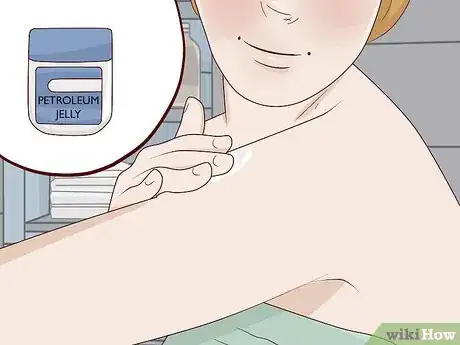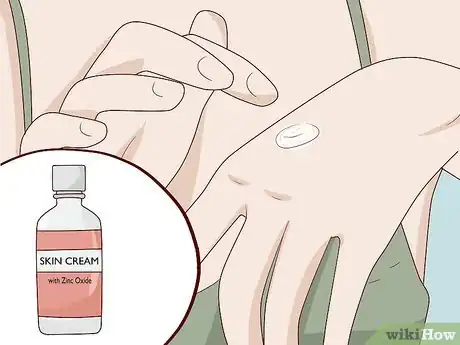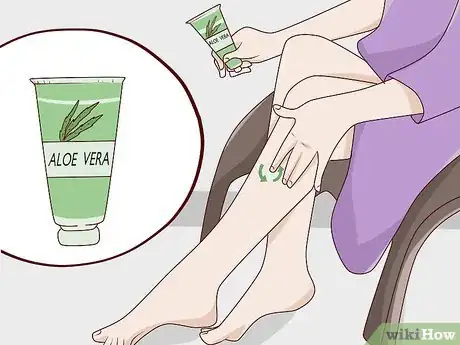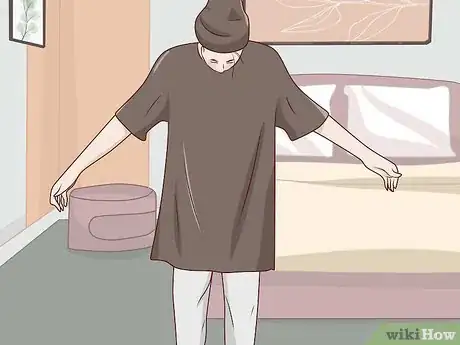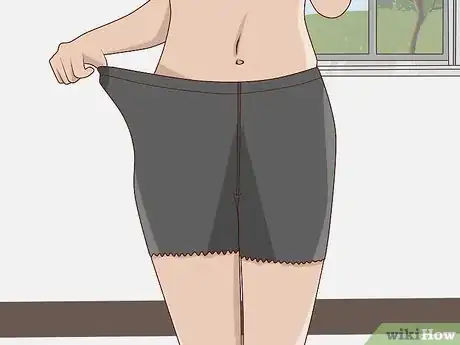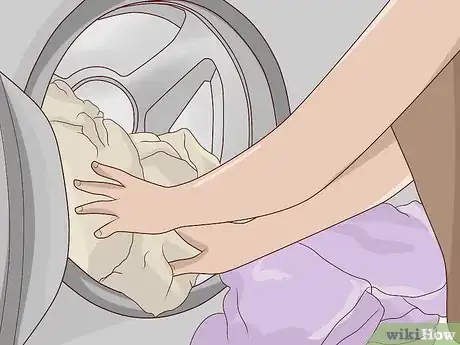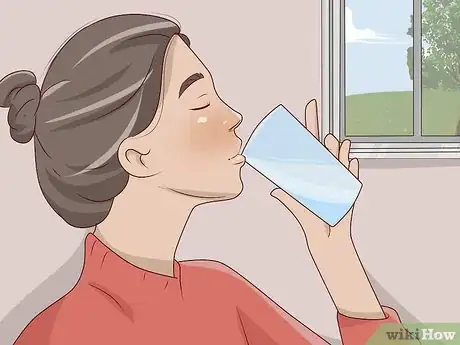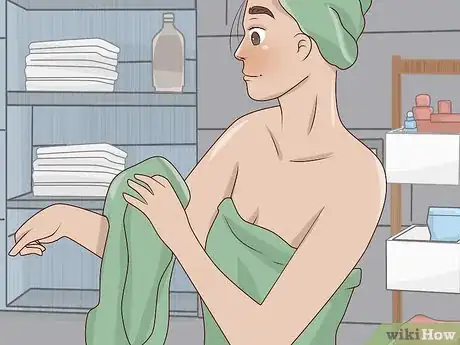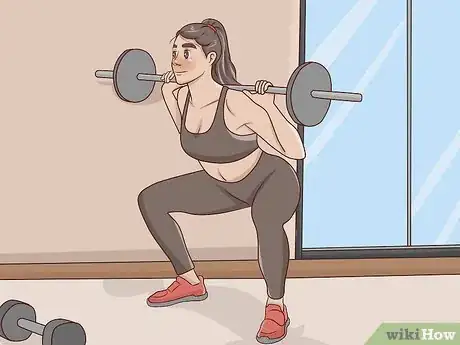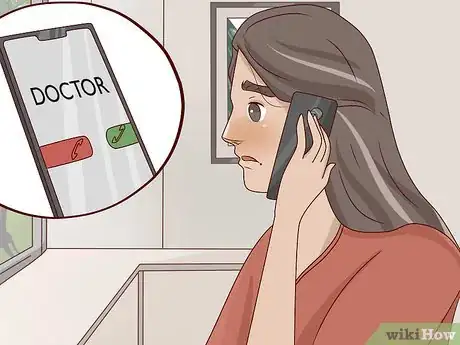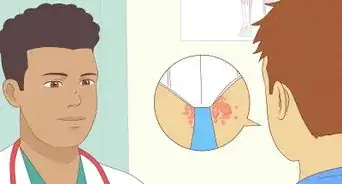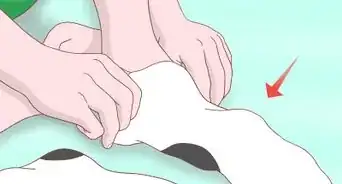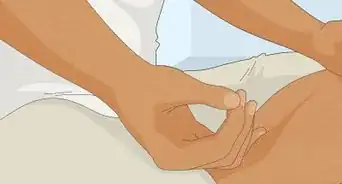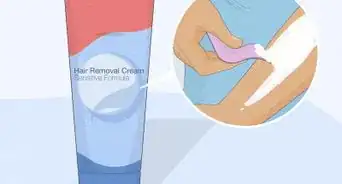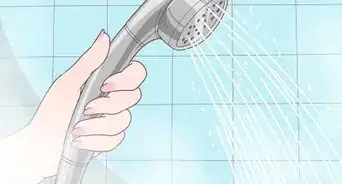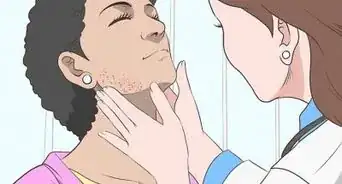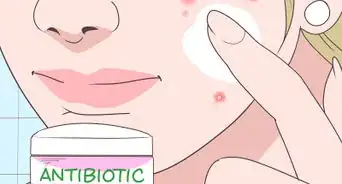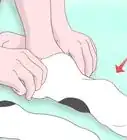This article was co-authored by Zora Degrandpre, ND and by wikiHow staff writer, Eric McClure. Dr. Zora Degrandpre is a Natural Health Doctor and Licensed Naturopathic Physician in Vancouver, Washington. She is a grant reviewer for the National Institutes of Health and the National Center for Complementary and Alternative Medicine. She received her ND from the National College of Natural Medicine in 2007.
There are 7 references cited in this article, which can be found at the bottom of the page.
This article has been viewed 105,915 times.
Chafing is caused when skin, clothing, or another part of your body rubs against your skin and causes irritation. Chafing most commonly occurs on the inner thighs, groin, underarms, and nipples. It’s an extremely common issue, so don’t worry that there’s something seriously wrong. In most cases, a little moisturizer and relaxation are more than enough to clear it up. Keep in mind that sweating tends to make chafing worse, so it’s probably a good time to take a break from working out. If your chafing doesn’t go away with treatment, talk to your doctor to see if there is some other underlying issue.
Steps
Lubricating and Moisturizing Your Skin
-
1Rub some petroleum jelly into the skin to reduce friction. The main cause of chafing is usually friction. To lubricate your skin, scoop up a chunk of petroleum jelly and rub it directly into your skin. This will keep your skin from rubbing against anything else while you’re out and about. It will also help repair your skin by protecting the pores from irritation.[1]
- You can use shea butter or coconut oil instead of petroleum jelly if you prefer. You may need to reapply the butter or oil every couple of hours, though. Petroleum jelly is great because it tends to keep skin lubricated for a longer time by trapping moisture in.
- Petroleum jelly isn’t completely natural, but there isn’t really anything in it that will cause your skin harm. The vast majority of the ingredients are from natural sources, though.
-
2Use a cream or lotion with zinc oxide to repair the skin. Pick up an organic cream or lotion with zinc oxide in it to help your skin heal. Rub a quarter-sized dollop directly into your skin, which will protect your skin by filling in the pores. It is highly effective at repairing chafing. However, it’s not the best lubricant, so you’re better off waiting to apply the zinc oxide until you get home.[2]
- Zinc oxide is one of the most common ingredients used to treat dermatitis, eczema, acne, and other skin conditions.
Advertisement -
3Apply aloe vera to the skin to minimize pain if necessary. If your chafing has moved from irritating to painful, grab some aloe vera. Rub a pea-sized drop of aloe vera directly into your skin using smooth, circular motions. The menthol in aloe vera will soothe the pain from the sensitive skin.
- Reapply the aloe vera whenever you feel the pain returning. Typically, the effects of aloe vera wear off after 1-2 hours.
Tip: Some people really dislike the minty feeling of aloe vera. If it doesn’t help relieve your pain, go ahead and stick with the zinc oxide or petroleum jelly.
Wearing the Right Clothes
-
1Wear loose-fitting clothing to keep your skin cool. Tight clothes can cause chafing as your skin rubs against the fabric. It also causes you to sweat, which can make the chafing worse. Avoid wearing clothes that are resting directly on your skin. Wear reasonably loose-fitting clothes to avoid friction and give your skin time to heal.[3]
- Avoid tight belts, tight underwear, and clothes that cause you to sweat. All of these are keeping your skin from breathing and can make your chafing worse.
- In the winter, you may want to do the opposite. Looser clothes may trap your body heat and make you sweat more.
-
2Opt for clothes made of cotton or some other breathable material. Wear cotton whenever you can. Fancy polyester shirts and denim trousers may be tempting, but they can trap heat and cause you to sweat which can trigger chafing. Cotton dresses, shorts, and shirts are easy to find in a variety of styles as well. Giving your skin room to breathe is the best way to give the skin time to repair naturally.[4]
- In general, you should always choose materials that feel good against your skin. Avoid any materials such as wool and leather.
Tip: When exercising, some people prefer synthetic materials that wick away moisture. These synthetic materials help reduce perspiration and dry faster than natural materials. However, if you aren’t working out, they’re probably not an ideal choice.
-
3Wear some anti-chafing shorts if the issue is with your thighs. Many people chafe between the thighs when they’re running or working out. If this is you, pick up a pair of tight-fitting anti-chafing shorts. These shorts have padding for your thighs to keep the friction from doing damage. Since it’s hard to let this area breathe, this is probably the best way to handle the irritation.[5]
-
4Wash your clothes after wearing them once to avoid irritation. The minerals and oils in your skin transfer to your clothing after you wear it. When you re-wear clothing, you’re exposing your chaffed skin to those minerals and oils. This can irritate the skin and increase the amount of time it takes to heal.[6]
Preventing Future Chafing
-
1Drink plenty of water to replenish fluids and dilute your sweat. The more water you drink, the less salt and minerals your sweat will contain. Drink at least 4-5 glasses of water a day to keep your skin looking and feeling great. You’re much less likely to chafe in the future if you stay well hydrated.[7]
- If you get sick of boring old water, add a slice of lime or lemon to the water!
-
2Keep your skin dry by wiping it clean and avoiding heat. Keep the temperature in your home cool enough so that you aren’t sweating. Avoid going out if it’s extremely hot outside. When you do sweat, brush the area gently with a dry, clean cloth. Avoiding sweat and keeping your skin dry is a great way to prevent chafing.[8]
- If your skin is so dry that it’s uncomfortable, use a cream or lotion to add some healthy moisture.
- Sweat can make chafing worse because it is relatively high in minerals that can irritate the skin even further. After sweating, remove your clothes, rinse off in the shower, and dry your skin completely.
-
3Shed a few pounds to prevent skin-on-skin contact. You have a higher chance of getting chafed skin if you’re overweight, especially when it comes to the thighs. Exercise regularly and eat a balanced diet of grains, fruits, vegetables, and lean proteins. The best way to lose weight is to burn more calories than you are consuming, so limit portion size and move around as much as possible.[9]
- Aim to eat healthy, well-balanced meals and avoid the fast food and sugary drinks.
- If you do drink a ton of sugary drinks, replacing soda and sports drinks with water is a great way to shed a little weight without breaking out the exercise equipment.
Tip: Talk to your doctor about good weight loss strategies. There is no one-size-fits-all when it comes to a weight loss program. Find something you enjoy, like cycling or sports, to stay motivated and happy.
When to Seek Medical Treatment
-
1See your doctor if your irritation doesn’t clear up with home treatment. Most of the time, chafing can be easily treated at home with simple remedies and lifestyle changes. If your chafing just won’t go away even after several days of home care, talk to your doctor. It’s possible that you’ve developed an infection in the broken skin, in which case they can prescribe an antibacterial or antifungal ointment that can help.[10]
- You should also see your doctor if your chafed skin is extremely painful or itchy enough to keep you awake at night. You should also see your doctor if you have other symptoms, such as a fever or swelling, redness, bleeding, or discharge in the affected area.[11]
-
2Call your doctor if you have a condition that makes you vulnerable to infections. Certain health conditions, such as diabetes, can increase your risk of developing skin infections if your skin becomes irritated or broken. If not treated properly, these infections can lead to serious complications.[12]
Talk to your doctor if you have chafing and:
Diabetes.
Poor circulation.
Any condition that weakens your immune system, such as HIV/AIDS or cancer. You’re also at risk if you take immune-suppressing medications, such as steroids or chemotherapy drugs.
Any condition that prevents you from frequently changing position, such as paralysis or an illness that requires extensive bed rest.
Malnourishment.
Obesity.
You’re older than 60.
-
3Discuss medical treatments for conditions that make chafing worse. Some medical conditions, such as excessive sweating (which is called hyperhidrosis), can make you more prone to chafing. Talk to your doctor about how you can treat the underlying cause of your chafing if it won’t go away on its own or constantly comes back.[13]
- For example, if you have hyperhidrosis, you might benefit from treatments such as prescription antiperspirants or medications that block the nerves associated with sweating.[14]
- If you have severe chafing related to obesity, your doctor may be able to recommend safe and effective approaches for managing your weight.
Warnings
- Cornstarch used to be a recommended method for chafing, but there’s evidence that bacteria and fungi are attracted to cornstarch, which can lead to skin infections.[15]⧼thumbs_response⧽
References
- ↑ https://goaskalice.columbia.edu/answered-questions/sports-bra-chafing-0
- ↑ https://www.utmb.edu/newsroom/article216.aspx
- ↑ https://goaskalice.columbia.edu/answered-questions/sports-bra-chafing-0
- ↑ https://goaskalice.columbia.edu/answered-questions/sports-bra-chafing-0
- ↑ https://scholarworks.wmich.edu/cgi/viewcontent.cgi?article=1006&context=humanperformance_faculty
- ↑ https://goaskalice.columbia.edu/answered-questions/sports-bra-chafing-0
- ↑ https://goaskalice.columbia.edu/answered-questions/sports-bra-chafing-0
- ↑ http://www.aafp.org/afp/2005/0901/p833.html
- ↑ https://www.aafp.org/afp/2005/0901/p833.html
- ↑ https://www.aafp.org/afp/2005/0901/p833.html
- ↑ https://www.mayoclinic.org/diseases-conditions/dermatitis-eczema/symptoms-causes/syc-20352380
- ↑ https://scholarworks.wmich.edu/cgi/viewcontent.cgi?article=1006&context=humanperformance_faculty
- ↑ https://www.mayoclinic.org/diseases-conditions/hyperhidrosis/diagnosis-treatment/drc-20367173
- ↑ https://www.mayoclinic.org/diseases-conditions/hyperhidrosis/diagnosis-treatment/drc-20367173
- ↑ http://www.aafp.org/afp/2005/0901/p833.html
About This Article
To treat chafing naturally, try massaging olive oil, castor oil, or lanolin into your skin to soothe and moisturize it. Afterwards, place some gauze over the area if you’d like to protect it from further contact with your clothing. Alternatively, try taking a bath with 1 to 2 cups of oatmeal, which has properties that can help reduce inflammation in the skin. You can also use a few bags of chamomile tea instead of oatmeal, since chamomile is known to help reduce itching and inflammation. To learn more, like how to make dietary changes that can help prevent chafing, read on!
